Andhra Pradesh is a prominent state located in the southern coastal region of India, known for its rich cultural heritage and vibrant history. It ranks as the seventh-largest state in the country and is the tenth-most populous, with Telugu being the primary official language and the most widely spoken tongue among its residents. Amaravati serves as the state capital, while Visakhapatnam is recognized as its largest city. Geographically, Andhra Pradesh is bordered by Telangana to the northwest, Odisha to the northeast, Chhattisgarh to the north, Karnataka to the southwest, Tamil Nadu to the south, and the Bay of Bengal to the southeast, boasting an impressive coastline of approximately 974 kilometers, making it the second-longest in India.
The history of Andhra Pradesh is marked by a continuous human presence that dates back over 247,000 years, evidenced by various archaeological findings. The earliest documented reference to the Andhra’s can be traced to the Aitareya Brahmana, a text from around 800 BCE that is part of the Rigveda. By 300 BCE, the Andhra’s, residing in the fertile deltas of the Godavari and Krishna rivers, were renowned for their military prowess, being second only to the Maurya Empire in the region.
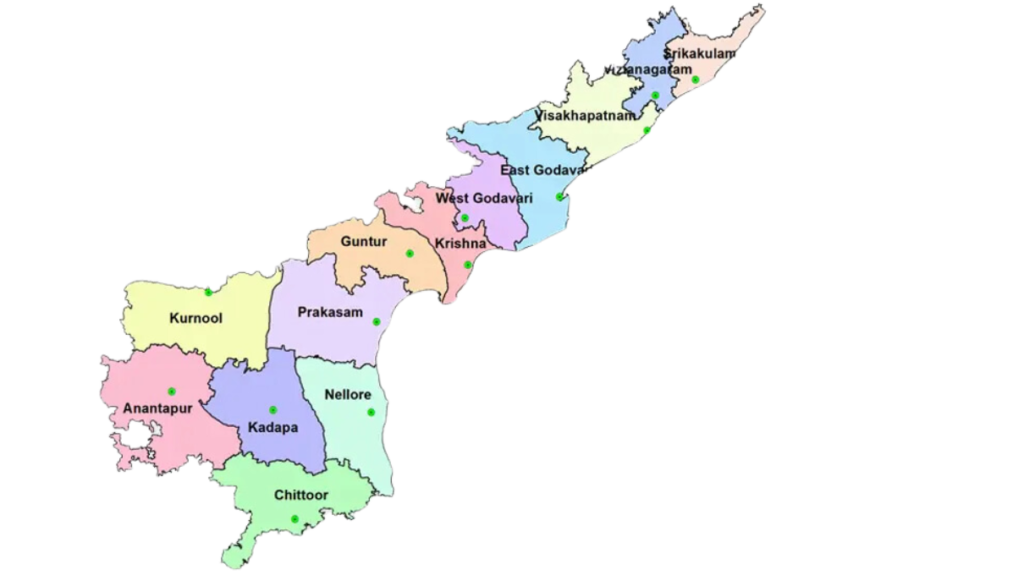
The first significant dynasty to emerge in the area was the Satavahana dynasty, which flourished from the 2nd century BCE to the 2nd century CE. This dynasty controlled vast territories across the Deccan Plateau and engaged in trade with the Roman Empire, showcasing the state’s historical significance as a center of commerce and power.
Throughout history, Andhra Pradesh has witnessed the rise and fall of several powerful dynasties, including the Vishnukundinas, Eastern Chalukyas, Kakatiyas, and the Vijayanagara Empire, along with periods of rule by the Qutb Shahis and the British Raj. In the modern era, Andhra State was carved out from the Madras Presidency in 1953, and in 1956, it merged with Telangana to form the unified state of Andhra Pradesh, encompassing Telugu-speaking regions from the erstwhile Hyderabad state. However, this union was short-lived, as the state was bifurcated again on June 2, 2014, leading to the creation of Telangana.
Andhra Pradesh: A Journey Through History and Culture
The diverse geography of Andhra Pradesh is characterized by the Eastern Ghats, which act as a natural barrier separating the coastal plains from the interior regions. Major rivers, including the Krishna, Godavari, and Penna, traverse the state, contributing to its rich agricultural landscape. Approximately 62.17% of the population is engaged in agriculture and related sectors, with rice being the predominant food crop and staple. The state plays a crucial role in India’s fish production, contributing to around 30% of the national output and accounting for 35% of total seafood exports.
Andhra Pradesh Land of Diversity
Andhra Pradesh is also home to Sriharikota, a barrier island in the Tirupati district, which serves as India’s primary satellite launching station, further highlighting the state’s significance in the field of science and technology.
Culturally, Andhra Pradesh has made significant contributions to the arts. The Amaravati School of Art, which originated in the region, is known for its distinctive style that has influenced various art forms in South India, Sri Lanka, and Southeast Asia. Additionally, Kuchipudi, one of India’s classical dance forms, originated in this state, showcasing its vibrant cultural heritage. The state is also associated with several renowned composers of Carnatic music, emphasizing its importance as a hub of musical innovation and tradition.
Religious pilgrimage sites and natural attractions abound in Andhra Pradesh. The Tirumala Venkateswara Temple near Tirupati is one of the most visited pilgrimage destinations in the world. Other notable sites include the Mallikarjuna Temple at Srisailam and the picturesque Araku Valley, which draw countless visitors each year.
The state is known for its unique products, many of which have received geographical indication registration. These include the Tirupati Laddu, celebrated for its taste and religious significance, Banganapalle mangoes, known for their sweetness, Kondapalli Toys, traditional handcrafted wooden toys, Dharmavaram sarees, characterized by their rich colors and intricate designs, and Pootharekulu, a delicacy made from rice paper filled with a mixture of jaggery and grated coconut.
In summary, Andhra Pradesh is a state that embodies a rich tapestry of history, culture, and economic vitality. From its ancient roots to its modern achievements, the state continues to be a vital contributor to India’s identity, offering a blend of tradition and progress that appeals to residents and visitors alike.
History
Pre-history
Archaeological discoveries in the Prakasam district, such as stone tools from Hanuman thumbpads, have been dated to approximately 247,000 years ago, suggesting the presence of archaic hominins in the region. This finding indicates that these tools were likely created by pre-modern humans during their migration out of Africa. Evidence of Neolithic settlements has also been found in the form of petroglyphs and dolmens in Chakrala Bodu near Boyalapalli village, further supporting the long history of human habitation in Andhra Pradesh.
Early and Medieval History
According to Megatheres, a Greek ambassador in the 3rd century BCE, the Andhra’s inhabited the fertile deltas of the Godavari and Krishna rivers and were renowned for their military prowess, second only to the Mauryan Empire. Archaeological sites such as Bhattiprolu and Amaravati indicate that the Andhra region was integrated into the Mauryan Empire. Following the decline of Mauryan influence around 200 BCE, local powers emerged, including the Satavahana dynasty, which dominated the region from the 1st century BCE to the 3rd century CE and established trade links with the Roman Empire. The Satavahanas made Dhanyakataka-Amaravati their capital, and the city was possibly the most prosperous in India during the 2nd century CE.

The region is also noted for the emergence of the Brahmi script, exemplified by inscriptions from Bhattiprolu, which played a crucial role in the evolution of Telugu and Kannada scripts. Following the Satavahanas, various dynasties, such as the Andhra Ikshvakus, Eastern Chalukyas, and Kakatiyas, ruled over the region, each contributing to the rich cultural tapestry. The Kakatiyas, in particular, were influential from the 12th to 14th centuries, but their reign ended with the advent of the Delhi Sultanate.
During the late medieval period, the Bahmani Sultanate and later the Vijayanagara Empire rose to prominence. The empire, especially during the reign of Krishnadevaraya, fostered significant advancements in art, literature, and architecture. The Lepakshi group of monuments, adorned with intricate murals and inscriptions, reflects the artistic achievements of this period.
Modern History
The decline of the Vijayanagar Empire led to the region falling under the control of the Qutb Shahi dynasty and eventually the Mughal Empire. By the early 18th century, Chin Qilich Khan, appointed by the Mughals as viceroy, became the semi-independent Nizam of Hyderabad. The British East India Company gradually extended its influence over Andhra Pradesh, culminating in the annexation of various territories, including parts of the Carnatic Sultanate and North Andhra, during the late 18th and early 19th centuries.

In the wake of the Indian Rebellion of 1857, the region became part of the British Crown. During this time, infrastructure projects like the Dowleswaram Barrage and the Buckingham Canal were developed to facilitate irrigation and transportation.
The struggle for linguistic identity led to significant political movements in the 20th century. In 1952, Potti Sreeramulu’s fast unto death sparked the demand for a separate state for Telugu speakers, resulting in the formation of Andhra State on October 1, 1953. This state was later merged with the Telugu-speaking areas of Hyderabad State on November 1, 1956, to form the larger Andhra Pradesh.
Post-independence, Andhra Pradesh saw a series of political changes, with the Indian National Congress dominating the landscape until the rise of the Telugu Desam Party (TDP) led by N.T. Rama Rao in the early 1980s. Major projects like the Nagarjuna Sagar Dam and Srisailam hydroelectric project were initiated to boost agriculture and electricity supply.
The state faced turmoil leading up to the bifurcation in 2014, which created Telangana, a new state carved from the existing Andhra Pradesh. Following this separation, the TDP formed the first government of the residual Andhra Pradesh, with Amaravati designated as the new capital. Recent political developments have included the leadership of Y.S. Jagan Mohan Reddy and efforts to expand administrative efficiency through the introduction of volunteer systems and the restructuring of districts.
Overall, the history of Andhra Pradesh reflects a complex interplay of cultural, political, and economic transformations that continue to shape its identity today.
Famous Cities
Andhra Pradesh is home to several cities that embody its cultural and economic diversity. Here’s a summary of some of the most notable cities:
- Visakhapatnam: Known as the “Jewel of the East Coast,” Visakhapatnam is a major port city with a thriving industrial base and beautiful beaches. It is famous for its rich maritime history, scenic hilltops, and vibrant culture.
- Vijayawada: This city serves as a significant commercial hub in the state and is renowned for the Kanaka Durga Temple, located on the Indrakeeladri Hill. Vijayawada is also famous for its lush greenery, historical sites, and the Krishna River.
- Amaravati: The current capital of Andhra Pradesh, Amaravati is known for its historical significance and modern development. It is an emerging city with ambitious infrastructure projects, including the construction of the new state legislature and administrative buildings.
- Tirupati: Famous for the Tirumala Venkateswara Temple, Tirupati attracts millions of pilgrims each year. The temple is one of the richest and most visited religious sites globally, making Tirupati a key center for tourism and spirituality.
- Kakinada: Known for its port, Kakinada is a hub for the export of seafood and agricultural products. The city is also recognized for its educational institutions and beautiful beaches.
- Nellore: Famous for its agriculture, particularly in rice cultivation, Nellore is also known for its unique cuisine, historical sites, and temples. The city is rapidly developing into an industrial center.
- Guntur: Guntur is famous for its chili production and is often referred to as the “Chili Capital of India.” The city has a rich cultural heritage and hosts several educational institutions.
Geography of Andhra Pradesh
Andhra Pradesh, located in southeastern India, is the seventh-largest state, covering an area of 162,970 km² (62,920 sq mi). The state shares its borders with Telangana to the northwest, Orissa to the northeast, Chhattisgarh to the north, Karnataka to the southwest, Tamil Nadu to the south, and the Bay of Bengal to the southeast. Notably, the Yanam district, an enclave of Puducherry, is situated within Andhra Pradesh, bordering the Kakinada district. The state’s coastline stretches approximately 974 kilometers (605 mi), making it the second-longest in India.

Topography and Natural Features
The Eastern Ghats serve as a prominent geographical feature, acting as a natural barrier between the coastal plains and peneplains. These hills, which are discontinuous and often referred to by local names, become more pronounced in the southern and northern extremes of the coastline. Significant hills in this range include the Horsley Hills, Seshachala Hills, Nallamala Hills, and Papi Hills. The highest peak in Andhra Pradesh is Arma Konda, located in the Visakhapatnam district. The peneplains in the Rayalaseema region slope toward the east, contributing to the state’s diverse topography.

The Eastern Coastal Plains extend from the Eastern Ghats to the Bay of Bengal, characterized by delta regions formed by the Krishna, Godavari, and Penna rivers. The state’s geography supports five distinct soil types, predominantly red lateritic and black soil, which are ideal for agriculture. The Kadapa basin, situated between two arching branches of the Eastern Ghats, is a mineral-rich area, further enhancing the state’s agricultural and economic potential.
Valleys and Caves
Among the notable valleys is the Araku Valley, celebrated for its rich biodiversity, and the Gandikota gorge, a stunning canyon formed by the Erramala range of hills, through which the Penna River flows. The Borra Caves, shaped by water activity over millions of years, and the Belum Caves, which are the second-longest cave system in India, are also significant geological features within the state. The coastal districts are home to several beautiful beaches, including Rushikonda, Mypadu, and Suryalanka, which attract both locals and tourists.

Flora and Fauna
Andhra Pradesh boasts a forest cover of 29,784.3 square kilometers (11,499.8 sq mi), accounting for 18.28% of the state’s total area. The forests in the Eastern Ghats region are dense and tropical, gradually becoming sparser as they transition to the peneplains, which typically feature shrub vegetation. The state’s vegetation primarily consists of dry deciduous forests, interspersed with teak and various genera, including Terminalia, Dalbergia, and Pterocarpus. Notably, the state is home to several rare and endemic plant species, such as Cycas beddomei and Pterocarpus santalinus.

As of 2019, Andhra Pradesh hosts three national parks and 13 wildlife sanctuaries, supporting a diverse range of fauna, including tigers, leopards, cheetals, sambars, sea turtles, and numerous bird and reptile species. The estuaries of the Godavari and Krishna rivers nurture rich mangrove forests, which are essential ecosystems that support keystone species such as fishing cats and otters. The Curinga Wildlife Sanctuary is an exemplary representation of mangrove forests in the state, while other notable sanctuaries include the Nagarjun Sagar-Srisailam Tiger Reserve and Kolluru Bird Sanctuary.
The neem tree (Azadirachta indica) is recognized as the state tree, jasmine as the state flower, the rose-ringed parakeet as the state bird, and the blackbuck as the state mammal, symbolizing the region’s natural heritage.
Mineral Resources
The geological diversity of Andhra Pradesh has endowed it with a wealth of mineral resources. The state is rich in various industrial minerals and building stones, including beach sand, bauxite, limestone, granite, and diamonds. Minor minerals found in abundance include barytes, calcite, and mica. One of the most significant mineral reserves is the largest deposit of uranium located in Thummalapally village in YSR district, alongside reserves of oil and natural gas that further contribute to the state’s economic landscape.

Climate
The climate of Andhra Pradesh varies significantly across its geographical regions. The summer months span from March to June, during which temperatures in the coastal plains can exceed 35 °C (95 °F), with minimum temperatures around 20 °C (68 °F) in the far southwest. The southwest monsoon brings tropical rains from July to September, while winter extends from October to February. During this period, low-pressure systems and tropical cyclones can form in the Bay of Bengal, causing significant rainfall in the southern and coastal regions.
The state generally experiences winter temperatures ranging from 30 to 35 °C (86 to 95 °F), except in the northeastern areas, where temperatures can dip below 15 °C (59 °F). Lambasingi in the Visakhapatnam district, often referred to as the “Kashmir of Andhra Pradesh,” is notable for its cool temperatures, ranging from 0 to 10 °C (32 to 50 °F). The average annual rainfall across the state is about 966 mm (38.0 in), highlighting the diverse climatic conditions that influence agriculture and daily life in the region.
Culture of Andhra Pradesh
Overview of Andhra Pradesh Culture
Andhra Pradesh, a southern Indian state, boasts a rich tapestry of cultural heritage influenced by its history, geography, and diverse traditions. With a vibrant blend of art, music, literature, cuisine, and festivals, the culture of Andhra Pradesh reflects the ethos of its people. From ancient sculptures and temples to contemporary dance forms and culinary delights, the state’s culture is a beautiful amalgamation of the traditional and the modern.

Museums and Heritage Sites
Andhra Pradesh is home to 32 museums that house a diverse collection of artifacts, including ancient sculptures, paintings, religious idols, and historical inscriptions. The Amaravati Archaeological Museum showcases the artistic traditions of Amaravati, featuring exquisite Buddha images. In Vijayawada, the Bapu Museum offers insights into history through stone carvings, coins, and weaponry. The Telugu Samskruthika Niketanam in Visakhapatnam highlights pre-independence historical artifacts, emphasizing the state’s rich legacy.

Notably, the Archaeological Survey of India has identified 135 centrally protected monuments within the state, including the reconstructed sites at Anupu and Nagarjunakonda. The state also proudly holds 17 geographical indication (GI) registrations, recognizing its unique agricultural, handicraft, food, and textile products as per the Geographical Indications of Goods (Registration and Protection) Act of 1999.
Traditional Attire
The traditional clothing of Andhra Pradesh reflects the state’s cultural richness. Men typically wear the Panche, a non-stitched cloth measuring about 4.5 meters (15 feet) in length, often bordered with colorful stripes. Women traditionally don the sari, a beautiful drape ranging from 5 to 9 yards (4.6 to 8.2 meters) in length, showcasing vibrant colors and intricate patterns. Special occasions, such as weddings, see women adorned in exquisite silk saris.
Young girls traditionally wear a half-saree, which consists of a blouse and a long skirt, while the younger generation increasingly adopts Western attire like pants and shirts. Alongside traditional wear, salwar kameez has also gained popularity among women. Notable textiles from the region, like Dharmavaram textiles and Machilipatnam Kalamkari, have received GI status, symbolizing the state’s craftsmanship.
Culinary Delights
Andhra Pradesh is celebrated for its spicy and flavorful cuisine, characterized by a combination of tangy, sweet, and savory tastes. Chillies, tamarind, and gongura (roselle leaves) are staples in local cooking, contributing to the distinctive flavor profiles of Andhra meals. Common dishes include Pappu (lentil preparations), Pulusu (tamarind-based stew), and a variety of chutneys like Pachchadi made from groundnuts and fried vegetables.

Pulihora, a tangy tamarind rice dish, is especially popular and is often offered as prasadam (divine offering) in temples. Other favorites include vegetarian curries like Dondakaya koora (ivy gourd curry) and Guttivankaya koora (stuffed brinjal curry), along with non-vegetarian dishes such as Royyala koora (prawn curry) and Natukodi koora (country chicken curry).
The state also has a rich tradition of sweets, with items like Ariselu, Burelu, and Kakinada Khaaja being particularly popular during festivals. Many of these dishes, including Bandar laddu and Tirupati Laddu, have received GI recognition, showcasing the culinary heritage of Andhra Pradesh.
Literary Heritage
The literary landscape of Andhra Pradesh has flourished over the centuries, producing notable poets, philosophers, and writers. The trinity of Nannayya, Tikkana, and Yerrapragada played a pivotal role in translating the Mahabharata into Telugu during the 11th to 14th centuries. Nannayya’s work on Telugu grammar, Andhra Shabda Chintamani, laid the foundation for Telugu literature.
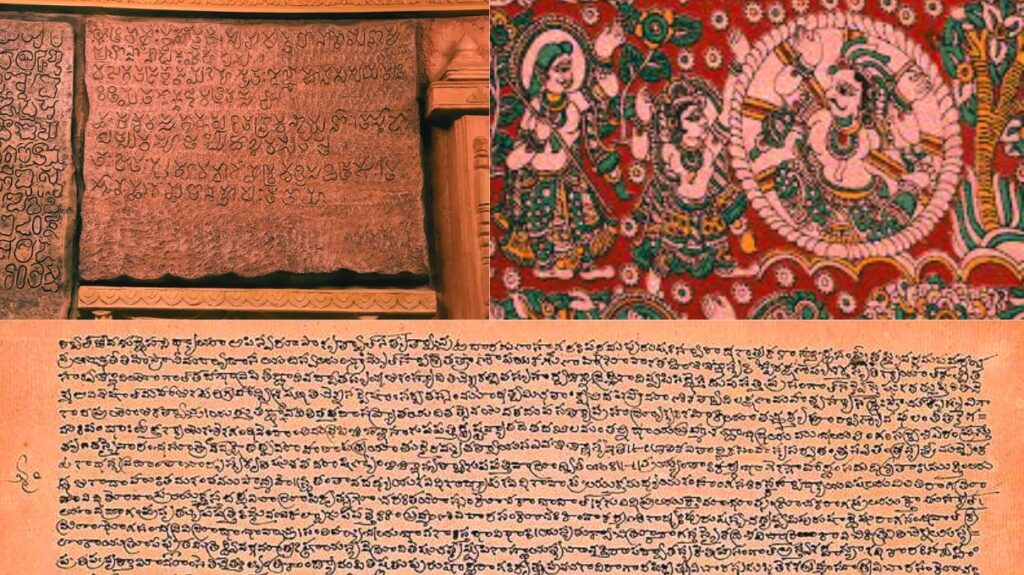
Prominent figures like Pothana, who translated the Bhagavatam, and Vemana, known for his simple yet profound poems, significantly contributed to the literary heritage. The advent of modern Telugu literature, termed Adhunika Telugu Sahityam, began with Kandukuri Veeresalingam, who authored the first social novel in Telugu, Rajasekhara Charitram.
The evolution of Telugu poetry into various forms, including Bhava kavitvam (lyrical poetry) and Viplava kavitvam (revolutionary poetry), has been marked by influential poets like Gurajada Apparao and Sri Sri. The significance of literature in contemporary society continues, with notable contributions from both men and women writers, enriching the cultural fabric of Andhra Pradesh.
Architectural Marvels
The architectural heritage of Andhra Pradesh is marked by its stunning temples, showcasing the Dravidian and Vijayanagara styles. The Venkateswara Temple in Tirumala is a prime example of Dravidian architecture, characterized by its grand gopurams (ornate towers) and the vimanam (structure above the sanctum). The Vijayanagara style is exemplified by the Lepakshi Veerabhadra Temple, featuring a well-planned layout that includes the mukha mantapa (assembly hall) and the garbhagriha (sanctum sanctorum).
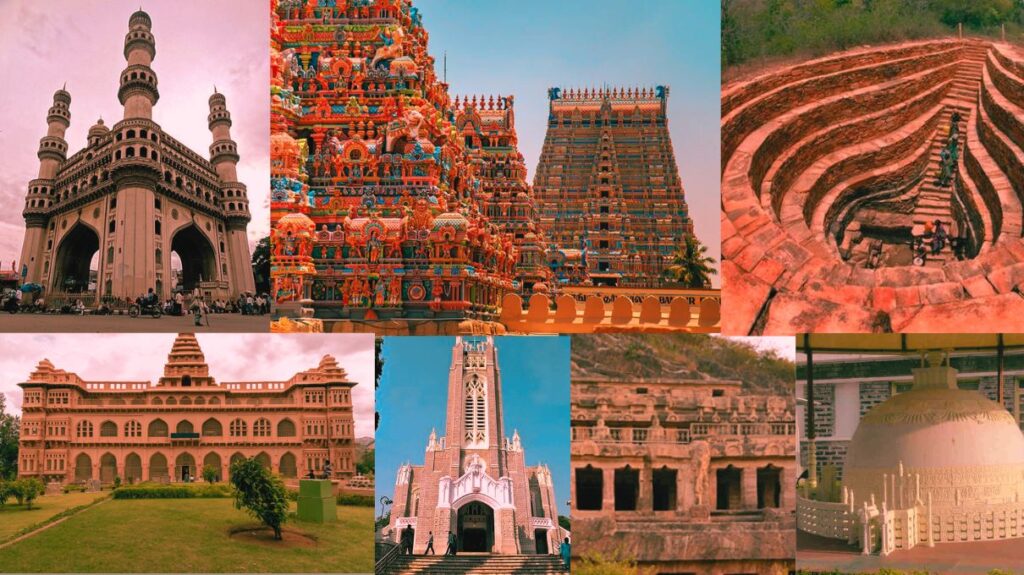
Performing Arts
Andhra Pradesh has a rich tradition of performing arts, with Kuchipudi being the state’s official dance form. Originating from the village of Kuchipudi, this classical dance combines expressive storytelling with intricate footwork and music. The state has also produced legendary composers of Carnatic music, including Annamacharya and Tyagaraja, whose contributions continue to influence the music scene.
Harikathaa Kalakshepam, a unique storytelling format, combines narrative with song, while Burra Katha provides a platform for oral storytelling that often addresses contemporary social issues. The Telugu film industry, popularly known as Tollywood, has gained international recognition, with films like RRR achieving global acclaim.
Festivals
The people of Andhra Pradesh celebrate a myriad of festivals that reflect their agricultural heritage and cultural diversity. Sankranti, the major harvest festival, is celebrated for four days in January, marking the onset of the harvest season. Uganda, the Telugu New Year, involves preparing and sharing Pachhade, a special pickle symbolizing life’s experiences.
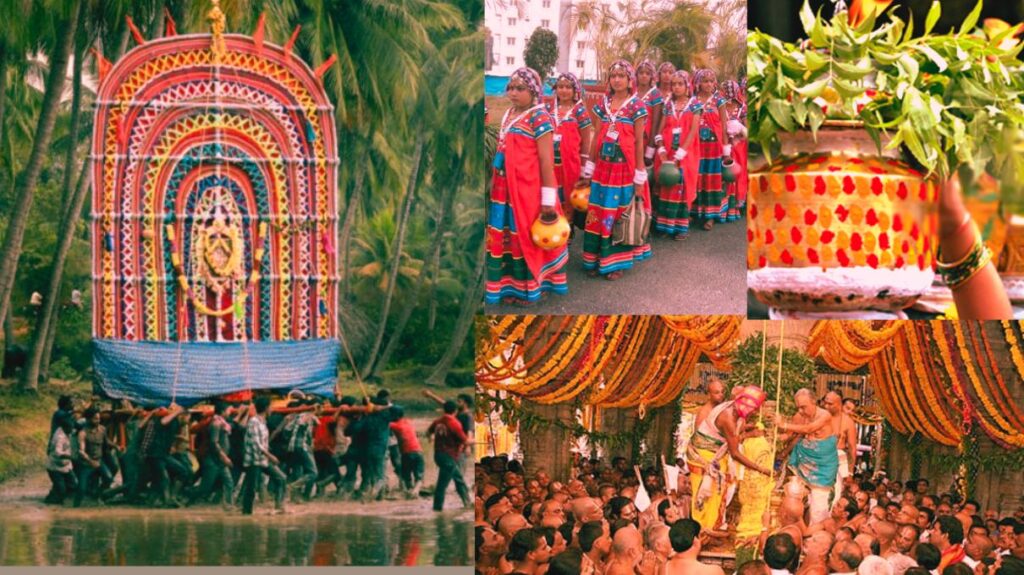
Other significant festivals include Vijaya Dasami (Dussehra) and Deepavali (the festival of lights), which are celebrated with great enthusiasm across the state. The unique Rotella Pandura at Bara Shaheed Dargah in Nellore emphasizes communal harmony, as people from various religious backgrounds participate in the celebrations.
Government and Administration of Andhra Pradesh
Andhra Pradesh’s governance structure reflects its political history and administrative needs. The state has a robust legislative framework comprising a unicameral legislative assembly and a legislative council. The legislative assembly consists of 175 assembly constituencies, while the legislative council serves as the upper house with 58 members. Representation at the national level includes 25 Lok Sabha and 11 Rajya Sabha seats.
Political Dynamics
The state’s political landscape is significantly influenced by the major communities, particularly the Reddy, Kamma, and Kapu communities, which collectively secured 66% of the seats in the 2019 elections. In the 2024 assembly elections, the TDP-led National Democratic Alliance, which includes the Jana Sena Party and Bhartiya Janata Party, triumphed over the incumbent YSR Congress Party (YSRCP), winning 164 seats compared to YSRCP’s 11. This marked a significant drop from the 151 seats YSRCP held. The victory of N. Chandrababu Naidu as chief minister for the fourth time was attributed to several factors, including widespread anti-incumbency sentiment and the alliance’s campaign promise of “Welfare with wealth generation”.
Law and Order
The Andhra Pradesh Police operates within a structured hierarchy encompassing districts, sub-divisions, circles, and police stations. However, law enforcement faces challenges, particularly concerning crimes against women and children, which saw a 43.66% increase in 2022, totaling 25,503 cases. Additionally, the state reported 2,341 cybercrime cases, ranking fifth in the country.
The Andhra Pradesh High Court, located in Amaravati, is led by the Chief Justice and comprises 37 judges. The district judiciary follows a three-tier system, including district courts at the top, civil and assistant sessions courts in the middle, and junior civil and judicial first-class magistrate courts at the lower tier. Various special courts, such as family courts and industrial tribunals, also play essential roles in the judicial process.
Administrative Divisions
Historically, Andhra Pradesh is divided into two main regions: Coastal Andhra and Rayalaseema. The northern portion of Coastal Andhra is sometimes referred to as North Andhra, especially in discussions about regional development disparities. The state’s administrative structure is further broken down into 26 districts, 76 revenue divisions, 679 mandals, and 13,324 village panchayats, facilitating localized governance.
Urbanization and Population
The state has a significant urban population, with 123 urban local bodies, which include 17 municipal corporations, 79 municipalities, and 27 Nagar panchayats. According to the 2011 census, the urban population stood at 14.9 million (approximately 1.49 crore), with two cities, Visakhapatnam and Vijayawada, boasting populations exceeding one million.
Major Cities by Population
The following table summarizes the cities in Andhra Pradesh with the highest populations based on the 2011 census:
| City/Town | District(s) | Population |
|---|---|---|
| Visakhapatnam | Visakhapatnam, Anaka Palli | 1,728,128 |
| Vijayawada | NTR | 1,476,931 |
| Guntur | Guntur | 743,354 |
| Nellore | Nellore | 558,548 |
| Kurnool | Kurnool | 484,327 |
| Rajahmundry | East Godavari | 476,873 |
| Tirupati | Tirupati | 461,900 |
| Kakinada | Kakinada | 443,028 |
| Kadapa | YSR | 344,893 |
| Anantapur | Anantapur | 340,613 |
Government Revenue and Expenditure
In the fiscal year 2021-22, the Andhra Pradesh government’s total receipts reached ₹2.05 lakh crore (approximately US$25 billion), which included ₹53,284 crore (around US$6.4 billion) in loans. The state’s own tax revenue was reported at ₹70,979 crore (approximately US$8.5 billion), with the primary sources being the state goods and services tax (GST), sales tax/value-added tax (VAT), and state excise.
The total expenditure for the government was ₹1,91,594 crore, incorporating a debt repayment of ₹13,920 crore. The fiscal deficit stood at 2.1% of the Gross State Domestic Product (GSDP). Outstanding debt had risen to ₹3.89 lakh crore, accounting for 32.4% of the GSDP, exceeding the standard limit of 25% as prescribed by the Fiscal Responsibility and Budget Management Act.
The Comptroller and Auditor General’s report in 2023 raised concerns about the increasing revenue expenditure coupled with low capital spending, warning that this trend could adversely affect infrastructure development, aggregate demand, employment generation, and long-term revenue generation.
Economy of Andhra Pradesh
The economy of Andhra Pradesh is a dynamic mix of agriculture, industry, and services, contributing to its growth and development. For the fiscal year 2022–23, the Gross State Domestic Product (GSDP) at current prices is estimated to be ₹1,317,728 crore (approximately US$160 billion). The sectoral contributions to the GSDP are significant: agriculture accounts for 36.19%, industry for 23.36%, and services for 40.45%. The state experienced a growth rate of 7.02% at constant prices, slightly outpacing the national growth rate of 7%. With a GDP per capita of ₹219,518 (about US$2,600), Andhra Pradesh is making strides in economic development.
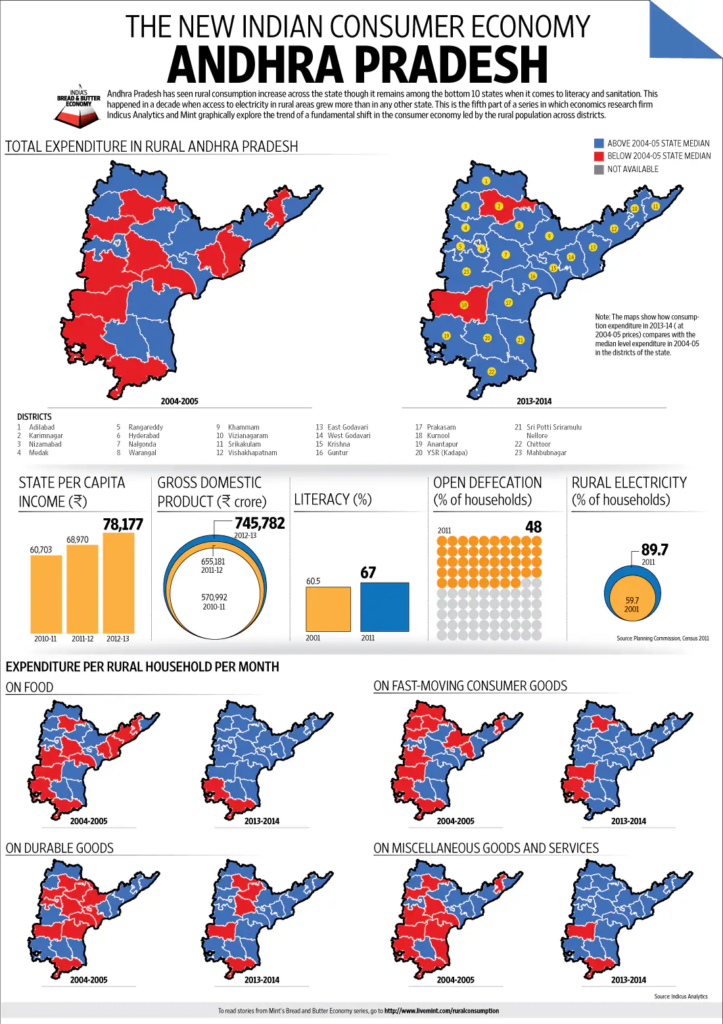
Poverty and Employment
The state’s efforts to combat poverty have seen success, with the poverty rate declining from 11.77% in 2015–16 to 4.2% in 2023, according to the Niti Aayog report. This assessment employs a global multidimensional poverty index based on ten indicators, covering areas such as health, education, and living standards. Despite these advancements, the unemployment rate for graduates in Andhra Pradesh remains high at 24%, ranking as the third highest in India, with the national average standing at 13.4%.
Agriculture
Agriculture plays a pivotal role in Andhra Pradesh’s economy, encompassing crop cultivation, livestock, poultry farming, and fisheries. The state is traversed by four major rivers—the Godavari, Krishna, Penna, and Tungabhadra—which facilitate irrigation across its lush agricultural landscapes. As of 2020–21, approximately 62.17% of the population was engaged in agriculture-related activities. Rice is the primary food crop, complemented by jowar, bajra, maize, various pulses, sugarcane, cotton, tobacco, fruits, and vegetables.
The state contributes 30% of India’s fish production and 35% of the country’s total seafood exports in 2022–23. Andhra Pradesh is home to three agricultural export zones: the undivided Chittoor district for mango pulp and vegetables, the undivided Krishna district for mangoes, and the undivided Guntur district for chilies. Banagan Palle mangoes have received Geographical Indication (GI) status, further boosting the state’s agricultural prestige.
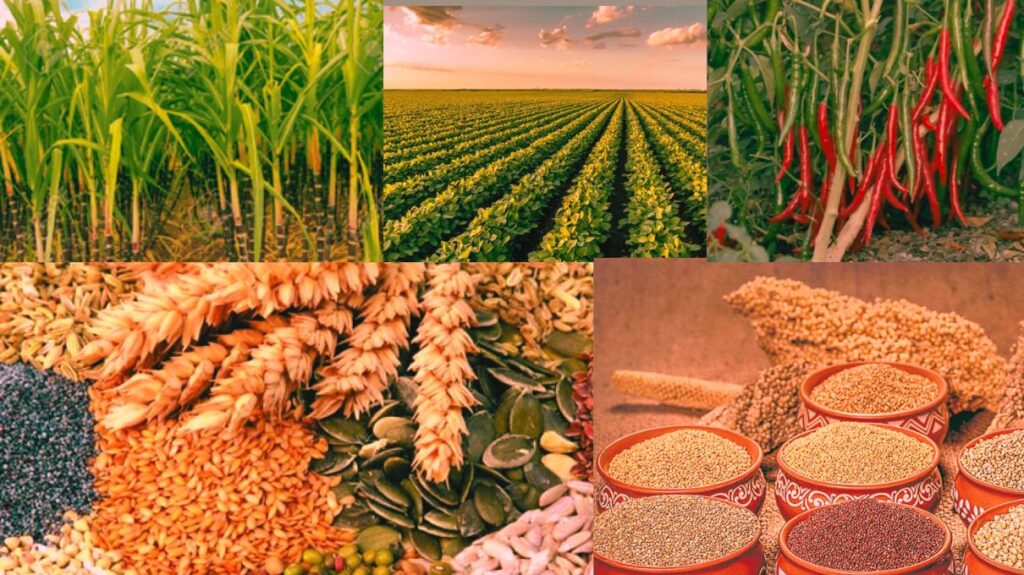
To support farmers, the government launched Rythu Seva Kendras (RSK) in 2020, providing comprehensive services from seed to sale. As of 2023, 10,778 RSKs are operational, enhancing accessibility to farming resources. The Andhra Pradesh Land Titling Act of 2023 aims to shift from a presumptive to a conclusive land ownership system, reducing disputes and facilitating easier land acquisition. However, the newly formed TDP-led NDA alliance government has proposed repealing this act due to concerns about potential misuse of authority.
Despite progress, challenges remain for tenant farmers, with estimates in 2021 suggesting about 16 lakh tenant farmers are engaged in cultivation, a significant portion of the total cultivated land. The Crop Cultivator Rights Act (CCRA) of 2019 aimed to assist tenant farmers, but only 26% obtained eligibility cards by 2022.
Industries
The industrial sector in Andhra Pradesh is diverse, with a focus on manufacturing and services. According to the Annual Survey of Industries (2019–20), there were 12,582 factories employing 681,224 workers. The major employment providers include food products (25.48%), non-metallic minerals (11.26%), textiles (9.35%), and pharmaceuticals (8.68%). The Gross Value Added (GVA) from the industrial sector reached ₹55,035 crore (approximately US$6.6 billion), with food products, pharmaceuticals, and non-metallic minerals being the top contributors.
The state is also a hub for automotive manufacturing, housing major players such as Ashok Leyland, Hero Motors, Isuzu Motors India, and Kia Motors. In addition to automotive, the state has a rich history in defense manufacturing, with the Hindustan Shipyard Limited establishing India’s first ship in 1948.

The mining sector contributed ₹3,390 crore (approximately US$410 million) in revenue for 2021–22. The state has produced nearly 225 million barrels of crude oil from the Ravva block in the Krishna Godavari basin between 1994 and 2011, contributing to 0.6% of India’s crude oil and 2.9% of natural gas production in 2020–21.
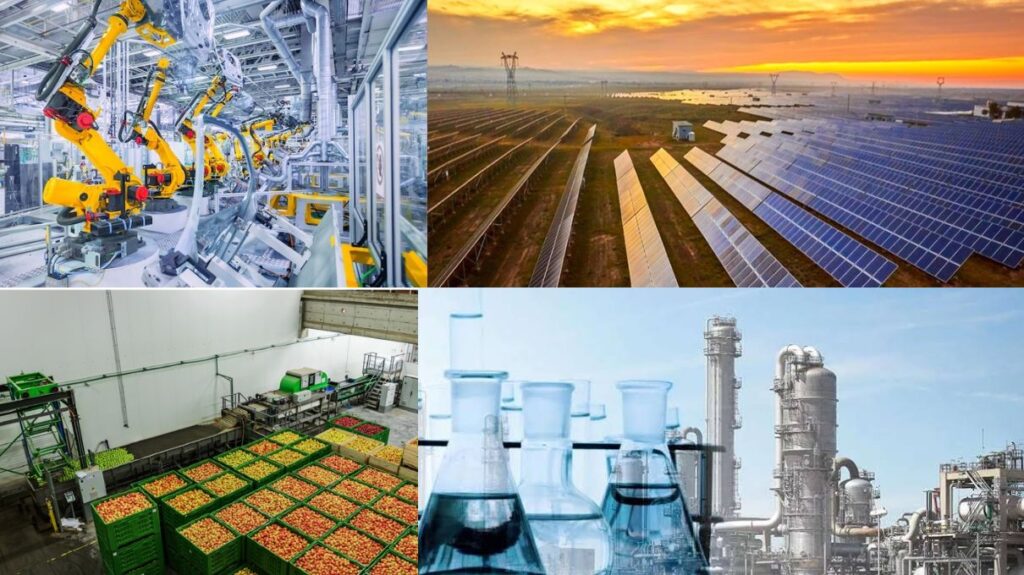
As of June 2023, Andhra Pradesh hosts 190 science and technology organizations, including 12 central laboratories and research institutions. The Satish Dhawan Space Centre (SDSC), located in Srihari Kota, serves as India’s primary satellite launching station, operated by the Indian Space Research Organization (ISRO). This investment in technology and infrastructure positions Andhra Pradesh as a significant player in the nation’s economic landscape.
Services Sector in Andhra Pradesh
In the financial year 2022-23, the services sector in Andhra Pradesh showcased significant growth, with the trade, hotels, and restaurants segment leading the way at an impressive rate of 16.64%. In contrast, public administration recorded the lowest growth rate of 4.24% at constant 2011-12 prices. This dynamic sector reflects the state’s economic vitality, with Andhra Pradesh ranking third in India for domestic tourism in 2021, attracting 93.2 million domestic visitors, which constitutes 13.8% of the nation’s total. Notably, a substantial portion of these tourists flock to revered temples in Tirupati, Vijayawada, and Srisailam.
Additionally, the state’s contribution to the information technology (IT) export market reached ₹926 crore (approximately US$110 million) in 2021-22, representing a mere 0.14% of India’s overall IT exports. Despite this growth, Andhra Pradesh’s export figures have consistently remained below 0.2% over the past five years.
Infrastructure Development
Transportation
As of 2023, Andhra Pradesh boasts a robust major road network spanning 47,244.83 km (29,356.58 mi). This includes 8,163.72 km of national highways, 12,595.60 km of state highways, and 26,485.51 km of major district roads. The NH 16, part of the Golden Quadrilateral project, is a key national highway covering approximately 1,000 km within the state.
In terms of public transport, the Andhra Pradesh State Road Transport Organisation (APSRTC) operates an extensive fleet of 11,098 buses, catering to about 3.68 million passengers daily across 129 depots divided into four zones. The service recorded operations of 1.11 billion kilometres as per the socio-economic survey of 2023.

Railways
The railway infrastructure in Andhra Pradesh has deep historical roots, with Renigunta being the first major station connected to the railway network in 1862. By 2022, the state had developed a total broad-gauge railway route of 3,969 km (2,466 mi), serving as a vital transportation link under the management of the South-Central Railway, East Coast Railway, and Southwestern Railway zones. The state has seen a surge in railway construction, with 350 km of new lines established from 2014 to 2022.
Air Transportation
Andhra Pradesh is served by three international airports located in Tirupati, Visakhapatnam, and Vijayawada, along with three domestic airports at Rajahmundry, Kadapa, and Kurnool. A new international airport is under construction in Bhogapuram, with an investment of ₹4,750 crore, expected to be operational by 2025. The state’s air travel saw a 60% increase in domestic passenger traffic, recording 24.74 lakh visitors during the fiscal year 2021-22.
Sea Ports
The state has one major port in Visakhapatnam and 15 notified ports, including three captive ports. Visakhapatnam Port, commissioned in 1933, is among the earliest in India, while Gangavaram Port serves as a deepwater port capable of accommodating large ocean liners. In the fiscal year 2023-34, these ports handled 189.21 million Tonnes of cargo, reflecting a growth of 7.9% compared to the previous year.
Communication and Water Management
As of January 2023, Andhra Pradesh houses 10,605 post offices and operates 1,310 telephone exchanges, with a significant number of mobile and internet users reaching 82 million and 67.1 million, respectively. The statewide area network supports communication across various administrative levels.
Water management in Andhra Pradesh is overseen by a system of 40 major rivers and numerous irrigation projects. The Polavaram Project, a crucial multi-purpose reservoir project, has faced several challenges, including delays due to flood damage.
Energy Sector
The state’s energy landscape includes thermal, hydel, and renewable sources, with a total installed capacity of 16,615 MW. Despite a growing demand for electricity, energy consumption has been sluggish, prompting discussions about improving infrastructure to meet the needs of its population.
Healthcare and Banking
Healthcare services include a network of 13 district hospitals and over 6,000 health centers across urban and rural areas. Emergency services and health insurance schemes cover millions of residents, ensuring access to healthcare.
In the banking sector, as of March 2023, there are 33 private sector banks and 12 public sector banks in operation, with a credit deposit ratio exceeding 144%. The microfinance industry, previously flourishing, is anticipated to rebound following recent regulatory changes.
Education in Andhra Pradesh
Education in Andhra Pradesh is administered through both government and private schools, with oversight by the state’s school education department. Recent reforms and policies have been implemented to enhance the educational landscape.
Primary and Secondary Education
The state has faced challenges in primary and secondary education, particularly exacerbated by the COVID-19 pandemic. For the academic year 2021-22, approximately 8.24 million students were enrolled in 61,948 schools across the state, according to the Unified District Information System for Education (UDISE+). However, a significant decline in performance was noted, especially in reading and arithmetic skills among rural students from grades 1 to 8, with reading assessment scores dropping from over 78% in 2018 to just 67% in 2022. Despite these setbacks, government school enrollment increased from 63.2% to 71%.

The secondary school certificate (SSC) examinations saw 616,615 students appear in March 2024, with a pass percentage of 86.69%, showing an improvement of 14.43% compared to the previous year. Notably, the Parvathipuram-Manyam district achieved the highest district pass percentage of 96.37%. In the same year, 393,757 students appeared for the intermediate (higher secondary) examinations, with a pass percentage of 78%, an increase of 7% from the previous year.
Educational Reforms and Developments
In response to the educational needs of the state, the government initiated a series of reforms in 2020, establishing different types of schools aimed at enhancing the quality of education. This includes the introduction of English-medium instruction across all government schools, a transition expected to be fully realized by the academic year 2024-25. A loan from the World Bank for $250 million has been allocated to support the “Supporting Andhra’s Learning Transformation” project, focusing on improving learning outcomes for early education.

As of 2023, Andhra Pradesh is home to 169 government-aided degree colleges and 55 private-aided colleges. The National Assessment and Accreditation Council (NAAC) has graded numerous institutions, with 66 government and 48 private-aided colleges receiving accreditation. The state hosts 685 technical institutions offering diploma, undergraduate, and postgraduate courses, with a total enrollment capacity of 299,608 students.
The Andhra Pradesh State Council of Higher Education conducts various entrance examinations and counseling sessions for admissions into higher education. As of 2021, there are 36 universities in the state, including three central universities, 23 state public universities, six private state universities, and four deemed universities. Andhra University, established in 1926, is the oldest university in the state. Additionally, the government has focused on skill development through the Andhra Pradesh State Skill Development Corporation, which supports vocational training and placements.

Despite the advancements, public universities are grappling with severe funding issues and staff shortages, operating with only about 20% of the sanctioned full-time faculty. In terms of performance, Koneru Lakshmaiah Education Foundation University and Andhra University ranked 50th and 76th, respectively, in the National Institute Ranking Framework for 2023, which included participation from 2,478 institutions nationwide.
Industrial Training and Libraries
The state has established 510 Industrial Training Institutes (ITIs) as of the 2020-21 academic year, with a total seat capacity of 93,280. However, only 48.9% of these seats were filled in 2021. Public libraries also play a critical role in promoting literacy and learning, with 2,510 public libraries registered across Andhra Pradesh, including regional and district libraries.
Media Landscape
Andhra Pradesh has a vibrant media landscape, with a total of 5,798 registered newspapers and periodicals for the year 2020-21, which includes 1,645 dailies and 817 weeklies. The top Telugu newspapers such as Eenadu and Sakshi have significant circulations. The state also hosts 45 television channels, including news, entertainment, and educational channels.
In summary, while Andhra Pradesh is making strides in improving educational infrastructure and access, it continues to face challenges related to performance disparities, funding, and staffing in educational institutions. The state’s commitment to reform and innovation in education is a vital part of its future development strategy.
Sports in Andhra Pradesh
Sports play an integral role in the cultural fabric of Andhra Pradesh, with a rich history of traditional games and modern sporting achievements.
Traditional Games and Martial Arts
Traditional childhood games such as Dagudu Mootalu (Hide and Seek), Chadarangam (Chess), and Puli Joodam (a local variant of tag) reflect the cultural heritage of the state. Karrasamu, a traditional martial art form, is practiced as a self-defense technique. This discipline is not officially recognized for sports quota reservations but showcases the state’s unique sporting culture.

Governing Bodies and Infrastructure
The Sports Authority of Andhra Pradesh is responsible for the governance and development of sports in the region. It oversees infrastructure development and coaching programs to promote various sports. The Sports Authority of India operates several training centers in the state, providing athletes with necessary facilities and training.
Notable Athletes
The state has produced several outstanding athletes who have achieved national and international recognition. Pullela Gopichand, a former badminton player, won the All England Open Badminton Championships in 2001. P.V. Sindhu is celebrated as one of India’s most successful athletes, with numerous medals from prestigious tournaments, including the Olympics. She became the first Indian to win a gold medal at the Badminton World Championships in 2019.

Other notable athletes include Karnam Malleswari, the first female Indian to win an Olympic medal in weightlifting, and Srikanth Kidambi, who achieved a historic silver medal in the men’s singles at the World Championships in 2021.
Recent Achievements
In recent competitions, Andhra Pradesh secured 16 medals at the 36th National Games in 2022 and excelled at the Asian Games, winning 11 medals across various sports. The state’s performance at the Khelo India Youth Games 2023 saw them ranked 13th, with a total of 27 medals.
In conclusion, Andhra Pradesh’s commitment to sports development, combined with its historical traditions and modern achievements, illustrates the state’s dedication to fostering athletic talent and promoting a vibrant sports culture.




